Since the modern mud (or slush) pump was built approximately 60 years ago, the industry has widely accepted the three cylinder or triplex style pump. Triplex mud pumps are manufactured worldwide, and many companies have emulated the original design and developed an improved form of the triplex pump in the past decade.
The triplex pump has a basic, simple design (see Figure 1).
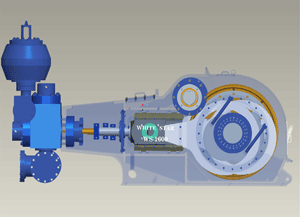
Figure 1a. Triplex pump side view
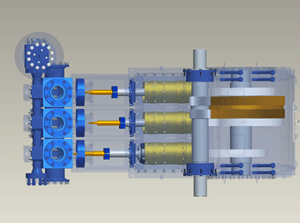
Figure 1b. Triplex pump plan view
As in all single acting pumps, the piston exerts a load on the crankshaft. The load is then transmitted to the crankshaft main bearings, which are set in their retainers in the pump frame or housing (see Figure 2).
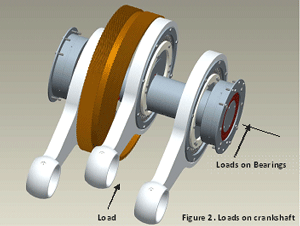
The middle piston often exerts seven times greater bending moment on the crankshaft than either of the outer two pistons, causing the crankshaft to bend or flex. Where the force is directed along either of the outer two piston rods to their respective outer two crankshaft cams, the force is close to the bearings and the bending moment is considerably less. However, when the center piston is under pressure and the forces are directed down the middle connecting rod to the central cam, the distance of that central cam from either main bearing is large (sometimes 850 mm or 33 in), thus allowing for a large bending moment and resulting in significant flex in the crankshaft.
As the crankshaft is subjected to these extremely high bending moments, it is inevitable that the crankshaft will suffer from cracking and fatigue (see Figure 3).
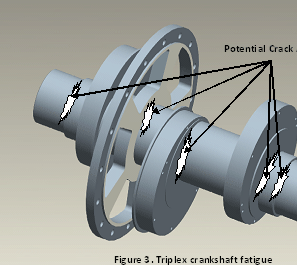
That the crankshaft is subjected to extreme bending loads and stress concentration areas is one of the drawbacks of the triplex design. Experience shows that all triplex pumps eventually exhibit crankshaft cracking if the operator is using the pump at higher loads and pressures, which is now common as drilling contractors are facing deeper, longer sections to drill. In the past, drillers rarely pushed the performance limitations of triplex pumps; 5,000 psi rated pumps were usually only operated at a maximum of 2,800 psi 90 percent of the time. Now contractors are encouraged to run pumps at the much higher pressures around 4,300 psi, only leaving a safety margin below the pressure relief valve setting. This means the crankshaft is subjected to extended maximum load, which inevitably shortens time to failure, probably exponentially.
Some may suggest that an increase in the number of pistons to improve flow rate will also reduce piston load. Although the middle piston load may be reduced for the same overall pump horsepower, the distance from the main bearings to the middle cam increases, which is not advantageous. For example, a five cylinder pump with the middle cam 50 in from the main bearing will have the same bending moment as a triplex with a 30 in middle cam to bearing distance. However, installing bearings close to the cams can reduce the cyclic failure problems on any pump.
To maintain the advantages of multiple cylinders, as required by many industrial applications, the solution has always been to position bearings close to the line of action. For example, in an industrial application, a bearing would be adjacent to every "big end" or connecting rod crankshaft cam, as in a large diesel engine (see Figure 4).
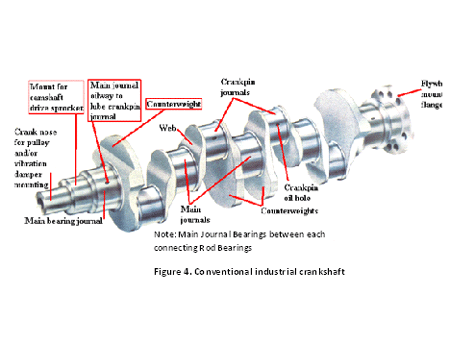
For the drilling industry, the problem with this design is that few have managed to design a crankshaft where bearings can be installed anywhere other than at the crankshaft ends. Consequently, most pumps currently available have crankshafts unsupported close to the middle cam. With the middle area of the crankshaft unsupported, crankshaft failure is inevitable.
Bearing types can amplify or reduce the loads exerted on a flexing crankshaft. If the bearing is a straight roller or taper bearing, the crankshaft is restricted, which causes a stress concentration problem where the crankshaft meets the bearing. This concentrated load creates cracks and sometimes shearing of the shaft exactly at the edge of the bearings.
A triplex pump with a large load acting on the middle of the crankshaft of approximately 120,000 lbs and a typical distance of about 30 in from middle cam to either main bearing will exert a bending moment of 300,000 lb-ft on the crankshaft adjacent to the main bearing. If the bearing is not spherical, the bending moment where the shaft meets the bearing will coincide with the point on the shaft that the crank can no longer bend because it is restricted by the fixed bearing, which creates huge stress concentration. That load comes and goes cyclically every revolution of the pump. If the pump is rotating at 100 rpm or strokes, then in one week of drilling the crank will experience one million cycles of 300,000 lb-ft effectively switching on and off.
A spherical bearing solves this problem and will not contribute to crankshaft failure. Spherical bearings allow the crankshaft to have a wave and flex without restraining the shaft and giving rise to stress concentration or shear (see Figure 5).
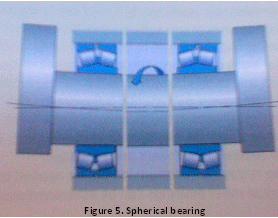
Another symptom of crankshaft deflection or bending is abnormal main gear wear patterns. The high unsupported load in the middle of the crankshaft effectively bows the shaft and consequently the bull gear is moved off alignment, and a strange wear pattern may appear on the gears. Although this is an undesirable occurrence, it is of little importance compared with crankshaft failure. It does explain abnormal wear on a pump used continuously at high pressure.
The case for welding or casting a crankshaft is arguable. While the cast crankshaft is strong and sometimes quite reliable, it is easy for casting anomalies like porosity and inclusions to be undetectable in inspection. Welded crankshafts always have a problem with the weld of the cams so close to a large diameter change, which can create stress concentration-induced problems. One way of avoiding both these problems is to have a modular crankshaft, which is assembled and disassembled without any welding or the need for subsequent heat-treating during manufacturing. All the crank components would be assembled from high quality forged parts that will last longer in any application and are unlikely to ever fail under normal or extreme conditions so long as the crankshaft is supported properly. (Figure 6 shows close bearing proximity to cams and spherical bearings.)
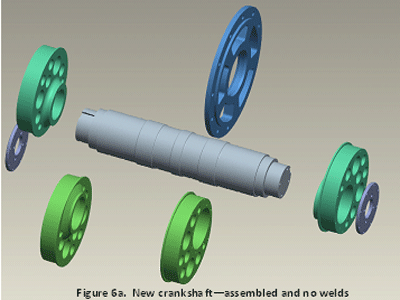
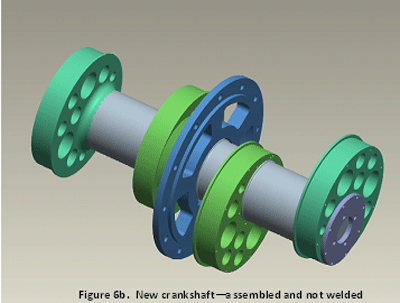
A pump that addresses these issues may be the solution. A quadraplex has minimal bending moments due to the close proximity of the main bearings to every cam (see Figure 7).
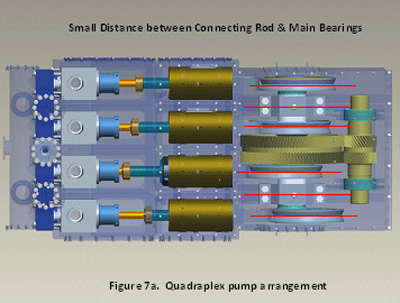
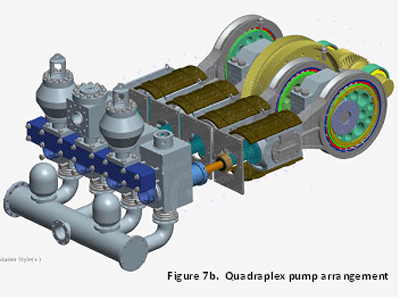
A fully assembled crankshaft is the best and only way to install multiple bearings close to the cams. Even though there is minimal flexure in this design, spherical bearings eliminate stress concentration or point loading. With cam to bearing distances no more than 10 in, the bending moment on a quadraplex crankshaft will be one quarter that of the triplex or five cylinder pump.

